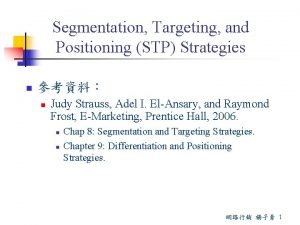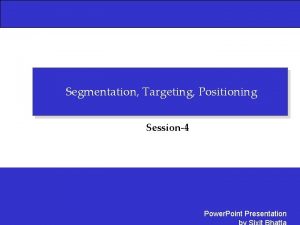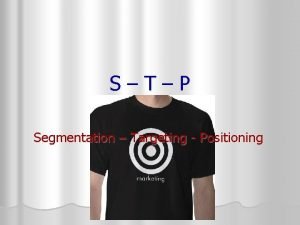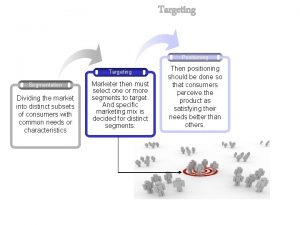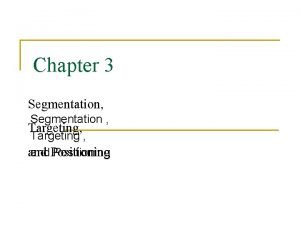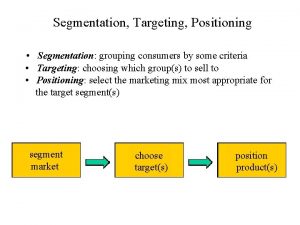Market segmentation Targeting Differentiation and positioning Dr S






























- Slides: 30

Market segmentation, Targeting, Differentiation and positioning Dr. S. CECILIYA

Market segmentation Differentiation Segmentation Create Value For Targeted Customers Targeting Positioning

Market segmentation Buyers in any market differ in their wants, resources, location, buying attitudes and buying practices. Through mkt segmn, companies divide large heterogeneous mkts into smaller segments, that can be reached more efficiently and effectively with pdts and services that match their unique needs.

Segmenting Consumer Markets A marketer has to try different segmentation variables, alone and in combination, to find the best way to view the mkt structure. 1. Geographic segmentation 2. Demographic segmentation 3. Psychographic segmentation 4. Behavioral segmentation


1. Geographic segmentation Dividing a mkt into different geographical units such as nations, states, regions, countries, cities etc. A coy may decide to operate in one or a few geographical areas, pay attention to geographic differences in needs and wants.

2. Demographic segmentation v. Dividing the mkt into groups based on variables such as age, gender, family size, family life cycle, income, occupation, education, race, generation and nationality. Ø Age and Life-cycle stage: consumer needs and wants change with age. Ø Gender: dividing a mkt into diff. gps based on gender. clothing, cosmetics, toileteries and magazines. Ø Income: dividing a mkt into diff. income gps.

3. Psychographic segmentation Marketers divides buyers into different groups based on social class, lifestyle or personality characteristics.

4. Behavioral segmentation Divides buyers into groups based on their knowledge, attitudes, uses or responses to a product. Ø Occasions: dividing the mkt into gps according to occasions when buyers get the idea to buy, Ø Benefits sought: dividing the mkt into gps accordg to the diff. benefits that con. Seek from the pdt

Cont. Ø User status: mkts can be segmented into non-users, ex-users, potential users, first-time users and regular users of a pdt. Ø Usage rate: mkts can be segmented into light, medium and heavy pdt users. Ø Loyalty status: a mkt can also be segmented by consumer loyalty. Consumers can be loyal to brands, stores and companies.

Requirements For Effective Segmentation Mkt segments must be 1. Measurable: size, purchasing power and profiles of segments can be measured. 2. Accessible: segments can be effectively reached and served. 3. Substantial: mkt segments are large or profitable enough to serve.

Cont. 4. Differentiable: distinguishable and respond differently to different markg mix elements and programs. 5. Actionable: effective programs can be designed for attracting and serving the segments.

MARKET TARGETING

Market Targeting Target market: A set of buyers sharing common needs or characteristics that the company decides to serve.

Market Targeting can be carried out at different levels. 1. Undifferentiated marketing 2. Differentiated marketing 3. Concentrated marketing 4. Micro marketing

1. 1. Undifferentiated Marketing(Mass) Undifferentiated Marketing: A market-coverage strategy in which a firm decides to ignore market segment differences and go after the whole market with one offer.

2. Differentiated Marketing(segmented) A market-coverage strategy in which a firm decides to target several mkt segments and designs separate offers for each.

3. Concentrated (niche) Marketing A mkt-coverage strategy in which a firm goes after a large share of one or a few segments or niches.

4. Micromarketing The practice of tailoring pdts and markg programs to the needs and wants of specific individuals and local customer gps – includes local marketing and individual marketing.

Local marketing: Tailoring brands and promotions to the needs and wants of local customer gps. -cities, neighborhoods and even specific stores. Individual marketing: Tailoring pdts and markg progms to the needs and preferences of individual customers – also labeled “one- to – one markg”, ”customized markg”, and markets of one markg.

Differentiation & Positioning

Differentiation And Positioning Product position The way the product is defined by consumers on important attributes-the place the pdt occupies in consumer’s minds relative to competing pdts.

Choosing a differentiation and positioning strategy 1. Identifying a set of differentiating competitive advantages 2. Choosing the right competitive advantages 3. Selecting an overall positioning strategy

1. Identifying positive value differences & competitive advantages Competitve advantage : an advantage over competitors gained by offering greater c/r value, either thro’ lower prices (or) by providing more benefits that justify higher prices. Thro’ pdt differentiation brands can be differentiated on features, performance or style and design.

2. Choosing the right competitive advantage How many differences to promote? Which differences to promote? ‘the extent that it satisfies the follg criteria’ 1. Important -the difference delivers a highly valued benefit to target buyers. 2. Distinctive-the coy can offer it in a more distinctive way. 3. Superior-the difference is superior to other ways that c/r’s might obtain the same benefit.

4. Communicable- the difference is communicable & visible to buyers. 5. Preemptive- competitors cannot easily copy the difference. 6. Affordable- buyers can afford to pay for the difference. 7. Profitable- the coy can introduce the difference profitably.

3. Selecting an overall positioning strategy The full positioning of a brand is called the brands value proposition. The full mix of benefits upon which the brand is differentiated & positioned. Possible value proposition: 1. More for more: this positioning involves providing the most upscale pdt or service & charging a higher price to cover the higher costs. Sellers offering”only the best”.

2. More for the same: coy’s can attack a competitors more for the same positioning by introducing a brand offering comparable quality but at a lower price. Mercedes & BMW The same for less: can be a powerful value proposition – every one likes a good deal. Discount stores – ‘Big Bazaar’

Less for much less- positioning involves meeting consumers lower performance or quality requirements at a much lower price. Maruti 800 offers very few features & less space, as a result –very lower price. More for less- winning value proposition –many coy’s claim to do this. Tata indica offers more space & better full economy at a lower price.

End
 Difference between segmentation targeting and positioning
Difference between segmentation targeting and positioning Positioning involves meeting consumers lower performance
Positioning involves meeting consumers lower performance Segmentation
Segmentation Sony market segmentation, targeting and positioning
Sony market segmentation, targeting and positioning Https://www.census.gov/popclock/
Https://www.census.gov/popclock/ Nokia market segmentation targeting and positioning
Nokia market segmentation targeting and positioning Market segmentation, targeting and positioning
Market segmentation, targeting and positioning Positioning methods
Positioning methods Market segmentation targeting and positioning of coca cola
Market segmentation targeting and positioning of coca cola Avon market segmentation
Avon market segmentation Nivea target market
Nivea target market Chapter 7 segmentation targeting and positioning
Chapter 7 segmentation targeting and positioning Segmentation targeting and positioning of nestle
Segmentation targeting and positioning of nestle Stp of maruti suzuki
Stp of maruti suzuki Segmentation bases
Segmentation bases Global segmentation
Global segmentation Global segmentation and positioning
Global segmentation and positioning Market segmentation and targeting ppt
Market segmentation and targeting ppt Positioning segmentation targeting
Positioning segmentation targeting Bases of market segmentation
Bases of market segmentation Market segmentation and positioning
Market segmentation and positioning Thompson rural market index
Thompson rural market index Three market segmentation strategies
Three market segmentation strategies Advanced hcp targeting
Advanced hcp targeting Strategie positioningu
Strategie positioningu Coca cola stp
Coca cola stp Segmentace targeting positioning
Segmentace targeting positioning Jurnal tentang stp
Jurnal tentang stp Value strategy marketing
Value strategy marketing Market follower
Market follower Market segmentation and selection
Market segmentation and selection














